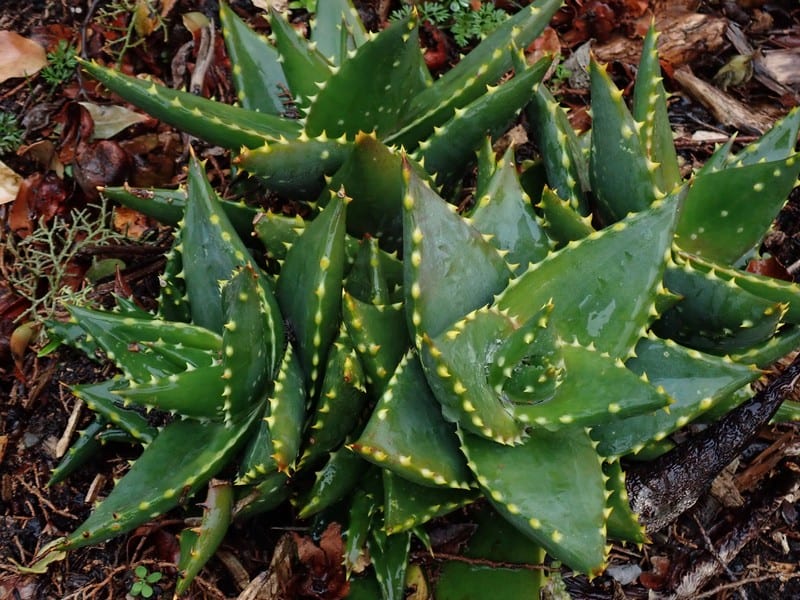Aloe perfoliata “Mitre Aloe” is endemic to the Western Cape and some adjacent areas in the North and East Cape of South Africa.
They are hung on vertical cliffs.
In their natural habitat, Aloe perfoliata have long prostrate and branched stems of up to approximately 2 meters.
This plant tends to spread across the ground and over the rocks.
If the Aloe perfoliata grows in full sun, its leaves take a bluish hue, while those in the shade, the leaves take on a green hue.
During dry conditions, the leaves assume a red color.
Aloe perfoliata leaves are thick and fleshy, with small white to yellow “teeth” along with the harmless leaves.
This type of aloe blooms abundantly in summer, unlike most aloes, which bloom in winter.
This plant’s flowers are red, which appear on the stems; their shape varies from round to cone-shaped.
Tips to take care of the Aloe Perfoliata “Mitre Aloe”
Illumination
All plants of the genus Aloe need a lot of light to grow healthy and bloom to the fullest.
It’s recommended to expose the plants to direct sunlight in the less warm times of the year and move to semi-shade or under filtered light in summer.
The intense summer sun is the main cause of many burns on the leaves of most species.
Temperature
They are plants that appreciate growing in cool or hot climates. Some species can survive in temperatures of 40°C/104°F ; They are plants of hot climates.
Temperatures below 10°C/50°F are dangerous for these plants because they encourage the proliferation of fungi in the roots and consequently, the rot of these plants.
In countries with extreme winters, it is always recommended to grow in vessels to be easily transported to a warmer environment (examples: greenhouses, home interior, etc.).
Substratum
They are mostly quite resistant to growing on a wide variety of substrates but provided they have optimal drainage and good aeration. 2/3 of universal substrate or garden soil with 1/3 of coarse sand or gravel can be used.
Watering Frequency
They are succulent plants very well adapted to tolerate extensive droughts; that is, they prefer water scarcity than excess.
They are susceptible to rot if the substrate remains wet for a long time.
It is advisable to water when the substrate has dried completely (usually 1-2 times weekly) if the plant is in the growing season; in a state of latency, we must reduce the frequency to biweekly or monthly.
Pruning
These plants are not pruned. Only leaves and flower spikes that have already dried should be removed to prevent them from being attacked by opportunistic pests.
You may remove dry leaf to avoid future pests.
You may like: Mother of Thousands vs Mother of Millions
Transplant
These plants are usually colonial, forming numerous daughter plants at their base, creating many plants in a single area.
In many cases, the pots do not support a large number of plants and tend to break (depends on the clear material); It’s recommended to transplant when the roots arise through the drainage holes or when the daughter plants protrude from the edge of the pot.
Plagues and diseases
They suffer attacks of mealybugs, aphids, snails, slugs and even birds.
All pests must be eradicated quickly to avoid severe damage to plant health or new pathologies associated with viruses or bacteria transmitted by these same pests.
The main enemies of this genus’s plants are fungi; these appear if the humidity is very high and the substrate flooded. Fungi are the main culprits in the death of many representatives of this group.
Propagation
Very simple to propagate; you can do it from the separation of small children that appear at the base of most species.
To separate these children, a sharp and disinfected object must be used to cut.
Then we must let the wound dry for 24 hours and then plant on a sandy and slightly moist substrate.
Seedlings should not be exposed to the sun until they take root.
Multiplication can also be carried out using seeds that we must germinate in a substrate made with 2/3 of coarse sand and 1/3 of universal substrate at 18-24°C 64°F/75°F.
